Worcester, Worcestershire
Up to 1834
In 1703, a local Act of Parliament (2 & 3 Ann. c.8) — the "Worcester: Poor Relief, Burial Ground and Hopmarket Act" — was passed by Parliament. The Act provided for a "Court" of elected Guardians to administer poor relief on a city-wide basis, including the erection of a workhouse in the old Foregate gate house. Amongst its many clauses, the Act specified that "No Cloth or Stuff manufactured in the Work-house, to be sold by Retail in Worcester City. But may be imployed for cloathing the Poor of the Corporation."
The workhouse had its financial ups and downs as noted by Daniel Defoe in the second volume of his Tour Through the Whole Island of Great Britain, published in 1742. He described the building as:
Opposite to this Workhouse, Robert Berkley, of Spetchley, Esq; erected a fine Hospital for Twelve poor Men, and gave 2000l. to build it, and 4000l. to endow it.
A parliamentary report of 1777 recorded three parish workhouses as then in operation in the city: St Clement (with accommodation for up to 20 inmates), St Martin (40), and St Nicholas (30).
In 1792, following a further local Act For the better Relief and Employment of the Poor of the several Parishes within the City of Worcester, and of the Parishes of Saint Martin and Saint Clement, which are Part within the City of Worcester, and Part within the County of Worcester, and for providing a Burial Ground for the Use of such Parishes, a new workhouse, or House of Industry, was erected on Tallow Hill on the eastern edge of the city. The new establishment, designed by George Byfield, was commended by Eden, in his 1797 survey of the poor in England:
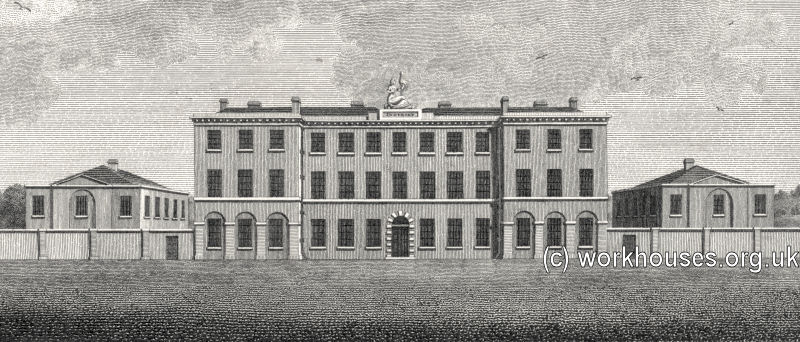
Worcester House of Industry from the west, c.1794.
© Peter Higginbotham.
At one time, the All Saints parish had a workhouse located on on Dolday.
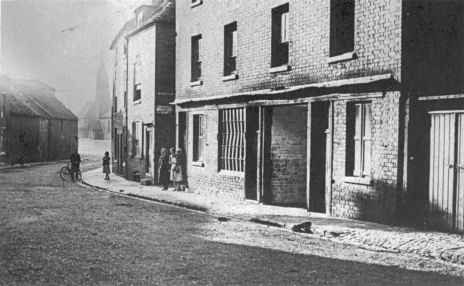
Former Worcester All Saints parish workhouse on Dolday, c.1930.
The parish of St John in Bedwardine had a workhouse from around 1816. It was located near St John's Green. In 1837, when the property was being re-let for other uses, the site was described as having a frontage of 86 feet 4 inches and being 89 feet deep.
After 1834
Worcester Poor Law Union was formed on 13th December 1836. Its operation was overseen by an elected Board of Guardians, 2 in number, representing its 12 constituent parishes as listed below (figures in brackets indicate numbers of Guardians if more than one):
Worcester City:
All Saints (2), St Alban, St Andrew (2), St Helen, St Michael in Bedwardine (3), St Nicholas (2), St Swithin. Later Additions: Blockhouse (1858), College Precincts (1858)
Worcester City/County:
St Clement (3), St John in Bedwardine (2), St Martin (2), St Peter the Great (2), Whitstone.
The population falling within the union at the 1831 census had been 26,542 with parishes ranging in size from St Alban (population 263) to St Martin (4,794). The average annual poor-rate expenditure for the period 1834-36 had been £6,140 or 4s.8d. per head of the population.
The new union took over the existing workhouse buildings at Tallow Hill which were adapted and enlarged. A separate infirmary was erected at the south of the site. The site layout at this period is shown on the 1886 map below.
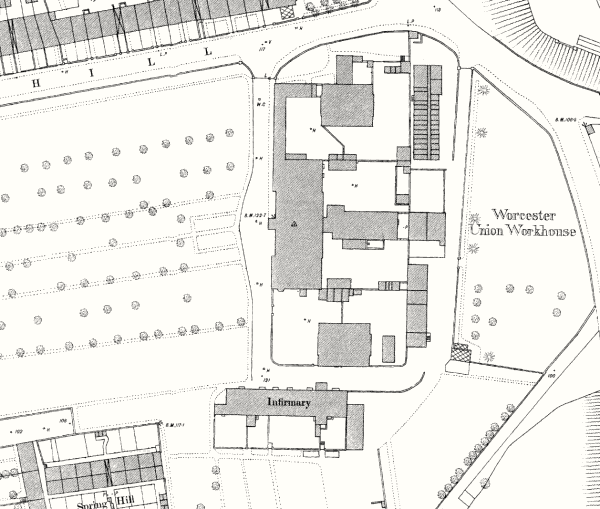
Worcester workhouse site, 1886.
In 1893-4, the workhouse was completely rebuilt, with only the existing infirmary being retained. The official laying of the foundation stone took place on May 18th, 1893 at 12.30pm. According to an article in The Worcester Herald on 22nd April, there had been some disagreement amongst the Guardians as to whether a ceremony should be held at all. One, Mrs Browne, felt that there was nothing to celebrate in the erection of such a building — it was rather a matter to be deplored that the erection of a workhouse was necessary at all. However, a ceremony took place and the (relocated) foundation stone can still be seen at the site.
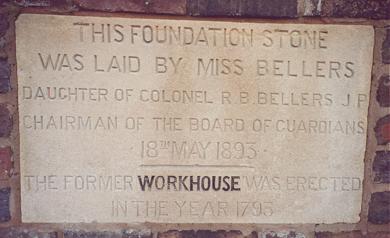
Worcester foundation stone, 2000.
© Peter Higginbotham.
The layout of the 1894 workhouse is shown on the 1904 below. It fronted onto Tallow Hill to the north, and was bounded by Hill Street to the west and Midland Road to the east.
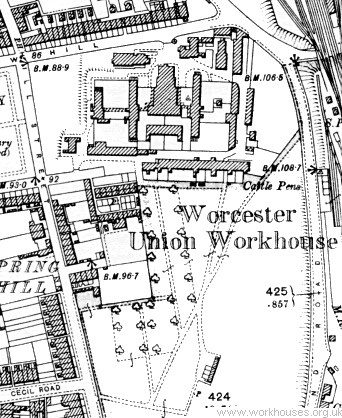
Worcester workhouse site, 1904.
Like many institutions of this period, Worcester was based on a pavilion-plan layout with separate blocks for the different categories of inmates. At the centre, opposite the entrance, was the Master and Matron's house, behind which lay the administrative block, kitchens and dining-hall. It was flanked by accommodation blocks with males on one side and females on the other. Reception and vagrants blocks lay at the north-east of the site, with an infirmary along the southern edge.
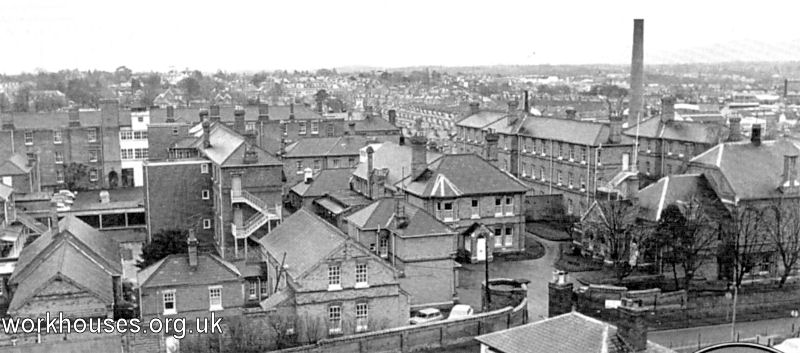
Worcester workhouse from the north-east. Courtesy of Mike Grundy / Worcester Evening News.
Although most of the workhouse buildings have now been demolished, some at the northern end of the site survive.
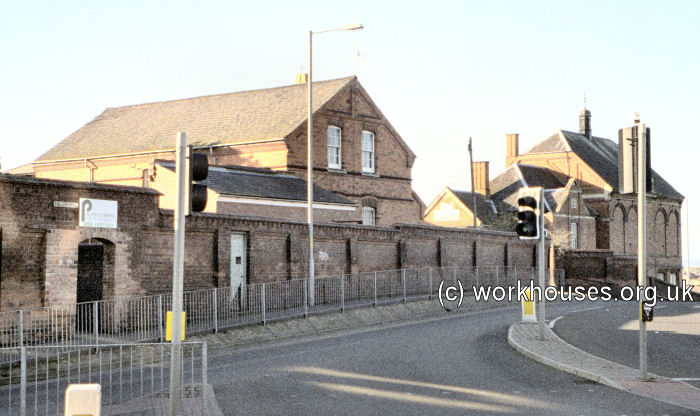
Worcester from north-east, 2000.
© Peter Higginbotham.
To the west of the entrance, bearing an 1894 date plaque, was the Guardians' boardroom.
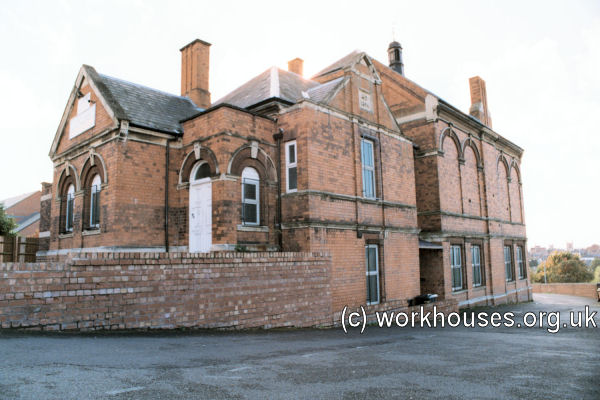
Worcester board-room block from the north-east, 2000.
© Peter Higginbotham.
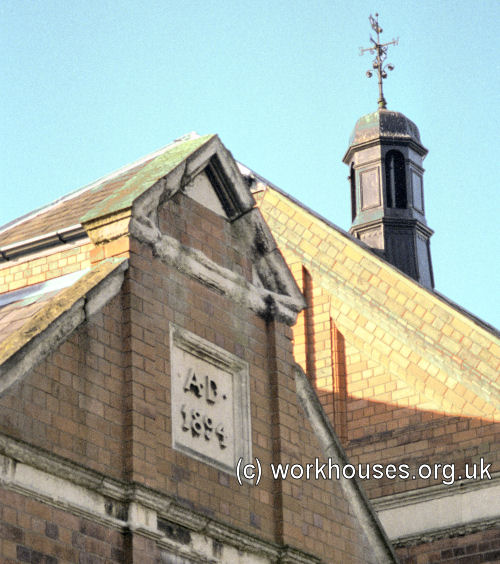
Worcester, 2000.
© Peter Higginbotham.
To the east of the entrance were the porter's lodge and reception and vagrants' block. The building immediately inside the gate later became the assistant matron's house and had a clothes store and sewing room at its rear.
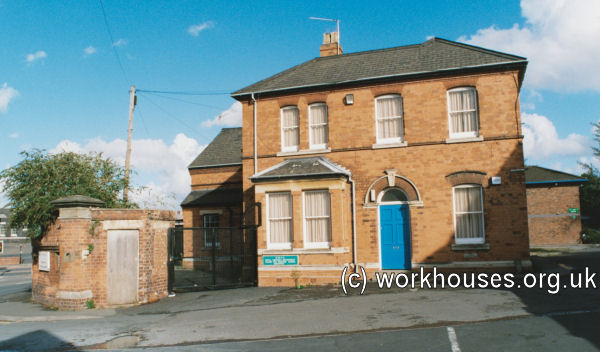
Worcester reception block from the west, 2000.
© Peter Higginbotham.
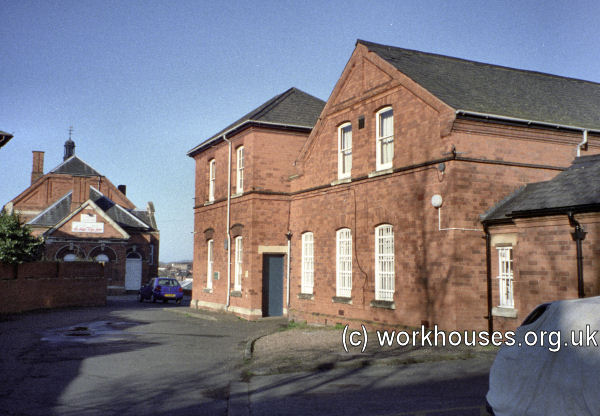
Worcester reception block from south-east, 2000.
© Peter Higginbotham.
The workhouse later became the Worcester Poor Law Institution. Between 1926 and 1954, it served as Shrub Hill infirmary, then became Hillborough home for aged which closed in 1978. The remaining buildings are now used as a training centre and a welfare hostel. The larger part of the site has been replaced by a modern housing development.
Cottage Homes
The Union operated some children's cottage homes on a 2.5-acre site to the south of the workhouse on the north side of Wyld's Lane, between Stanley Road and Midland Road. The homes were built in 1893-4 with their foundation stone being laid on the same day as that of the new workhouse. The Worcester Herald on 29th April, 1893, reported:
They are approached by driveways from Wyld's Lane and the new road west of the site. The Boys' block will have provision for industrial Master and Foster Mother, and a separate room for the purposes of committee meetings; the other blocks will also have accommodation for Foster Mothers. Especial attention has been paid to sanitation and ventilation. The work is being carried out by Messrs. J. Wood & Sons, contractors, the engineers portion being entrusted to Messrs. Benham & Son of London, and the whole from plans prepared by Messrs. Henry Rowe & Son, architects, of Worcester, and under their supervision.
The homes comprised three main blocks: one for boys at the west, one for girls at the east, and one for infants and the south. The site location and layout are shown on the 1904 map below.
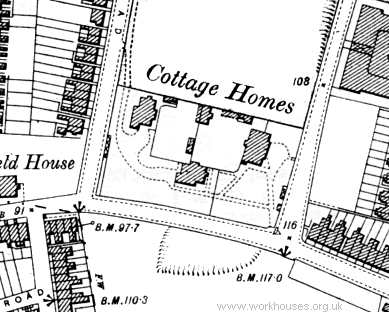
Worcester cottage homes site, 1904.
A further description of the new homes appeared in Berrows Journal on the 6th October, 1894.
The three blocks which form the Cottage Homes have anything but a Workhouse-like appearance.
They are erected at the end of Midland Road, on a high level and, in all the glory of the red and blue bricks, resemble rather three palatial villa residences. The style is Gothic. Every effort has been made to avoid any suggestion of pauperism. A Master and Matron supervise the three buildings and have control of the Boys' block in addition, and there are two assistant Matrons who reside at and have charge of the Infants' and Girls' departments.
Physical training is not neglected. Connected with each building are spacious playgrounds, asphalted with covered portions for use in wet weather. With an entrance from the boys' playground, the workshops have ample accommodation for any industrial pursuits the Guardians may decide in future to have taught.
The buildings are fitted according to modern ideas. Each of the Homes have proper lavatory and bathroom provision in their separate establishments. Small dormitories contain from 5 to 7 or 8 beds, and each child occupies a separate bed, this arrangement extending to the Infants' Home. In the Boys' block the work is done on a principle immortalised by Squeers. Each boy makes his own bed, and those who are above school age, and are waiting for situations outside the Home, find employment in scrubbing and general housework.
Everything is clean and tidy, smart, and in proper order — perhaps the training is better than in most homes.
Children at the homes had to perform domestic or other general work, according to their age. Tasks such as scrubbing could be quite hard and repetitive and were used as a form of punishment for misdemeanours. Failure to do a task properly meant doing it over again until those in charge were satisfied. The punishment records for 1902-22 record many "Bed B/W" entries — where a child was sent to bed without a meal except for bread and water. If a child wet the bed, they had to wash their own sheets in the bath, after which the got the slipper from the Master. One former resident from the period 1929-35 recalls that another boy soiled his bedclothes and was scrubbed in a bath of cold water with a bristled scrubbing brush. Another resident from 1939-41 recounts that if a child was caught swearing, they had to stand in front of the Matron (Mrs Shepherd) with a bar of carbolic soap in their mouth for ten or fifteen minutes.
However, things weren't entirely bad. The children, by the 1930s at least, received a little pocket money and a weekly sweet ration. The food was wholesome and plentiful even if a little predictable and unexciting. The weekly dinner menu was along the lines:
| Sunday: | Sunday roast |
| Monday: | Cold meat |
| Tuesday: | Mince |
| Wednesday: | Liver |
| Thursday: | Stew or Sausage and Mash |
| Friday: | Fish |
| Saturday: | Tinned meat |
Children from the homes had occasional outings on a river steamer or to local places of interest, often organised by local firms, clubs and societies. A new Master and Matron, Mr and Mrs Pledger, who arrived in 1945, introduced an annual holiday. This was an enormous exercise and effectively involved closing down the homes for two or three weeks. Holiday destinations included Abergele in North Wales, Skegness, a holiday camp at Dymchurch, and St Mary's Bay in Kent.
From 1931, the homes were known as the Municipal Homes. In July 1947, they were renamed Perryfields to remove the stigma that associated cottage homes with poor children. Between 1959 and 1961 the homes were wound down with the children being dispersed to a variety of locations. These including council houses which were knocked 'two into one' on Rea Way in Dines Green, Shap Drive in Warndon, and Don Road off Ronkswood Hill.
The buildings were demolished in 1992 and the site is now occupied by the Perryfields Day Centre which provides services for adults with learning disabilities.
Union Farm
There was a Union farm on Wyld's Lane just to the east of the cottage homes, at the east side of Midland Road. However, by 1904, the farm site had become used for housing.
Staff
Inmates
Records
Note: many repositories impose a closure period of up to 100 years for records identifying individuals. Before travelling a long distance, always check that the records you want to consult will be available.
- Worcestershire Archive and Archaeology Service, The Hive, Sawmill Walk, The Butts, Worcester, WR1 3PB. Relatively few nineteenth century records survive — holdings include: Guardians' minute books (1917-1930); creed register 1894-1958; etc.
Bibliography
- Payne, Eric (1994) The Perryfields and Cottage Homes Story
Links
- None.
Unless otherwise indicated, this page () is copyright Peter Higginbotham. Contents may not be reproduced without permission.


